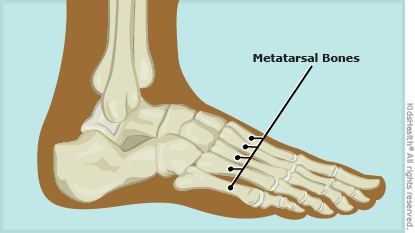The metatarsals are the five long bones in the foot that connect the toes to the ankle. Your child has a fracture (break) in one or more of these bones. Most foot fractures are treated with a special boot or splint (a support that is held in place with straps or an elastic bandage). Less often, a cast (hard bandage) is needed.
Take care of the boot, splint, or cast and treat pain as instructed to keep your child comfortable while the bone heals.

Follow your health care provider's recommendations for:
- how long your child needs to stay off the foot
- how to use crutches
- what activities are OK when your child can put weight on the foot (for example, your child may be able to walk at first but may need to avoid running)
- when to start stretching and strengthening exercises (usually a few weeks after the injury)
- when to follow up
To control swelling, for the first 2 days after the injury:
- Use pillows to raise the foot above heart level when your child is sitting or lying down.
- When your child is awake, put ice in a plastic bag wrapped in a towel on the outside of the boot, splint, or cast for 20 minutes every 3 hours. Don't put ice directly on the cast or skin.
If your child has pain:
- Put ice in a plastic bag wrapped in a towel on the outside of the boot, splint, or cast for 20 minutes every 3 hours. Don't put ice directly on the cast or skin. Check with your health care provider if it's OK to use ice more than 2 days after the injury.
- If your health care provider says it's OK, you can give medicine such as acetaminophen (Tylenol® or a store brand) or ibuprofen (Advil®, Motrin®, or a store brand). Follow the package directions for how much to give and how often.
Taking care of a boot:
- Follow your health care provider's instructions on when it's OK to take the boot off.
- Don't get the boot wet.
Taking care of a splint or cast:
- Keep the cast or splint clean. Keep dirt, sand, lotions, and powder away from it.
- Don't let your child scratch under the cast or splint or put anything in it.
- Don't pick at or remove the padding from the edges.
- Check the area daily. Make sure the skin is not scratched and the toes are not pale, blue, numb, or tingling.
- Keep it dry during bathing. Younger children can get a sponge bath. For regular baths or showers, you can cover the cast or splint with:
- two plastic bags sealed at the top with a rubber band (or tape)
- plastic wrap covered with a plastic bag that is sealed at the top
- a waterproof cast protector
- If it gets splashed, blow air into the cast or splint from a hair dryer on the cool setting.
Problems to watch for:
- Swelling: If the toes get swollen, have your child raise them above heart level for up to an hour.
- Sharp cast edges: If the skin near or under the cast gets red or irritated, put tape or moleskin (available at drugstores) on the edges.
- Itching: Don't let your child scratch or put anything into the cast for itching. Instead, tap lightly on the cast or use a hair dryer on the cool setting to blow air in and around the edges.

Your child can't move their toes, or the toes look white, purple, or blue.

How does a foot fracture happen? It usually happens when a heavy object lands on the foot. It can also happen when the foot twists (for example, during a fall).
How long does it take a foot fracture to heal? Most people with a foot fracture can go back to their regular activities within about 6–8 weeks. Full healing can take several months.




